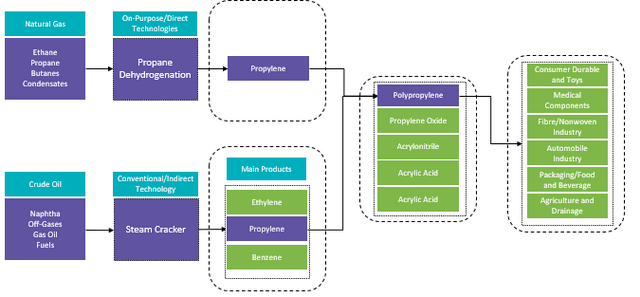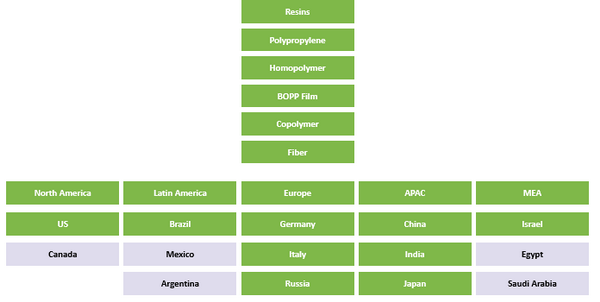The global polypropylene market is expected to reach USD 162 billion by 2025 growing at a CAGR of 4.9% from 2022-2025. Rise in disposable income, increasing demand from CPG, and automobile industry are likely to drive the growth in the emerging markets, such as Brazil and Asia.
PP Market Outlook
Demand from all downstream sectors of PP in the US are expected to come down, due to expected increase in federal interest rates in Q4 2022 and year-end destocking activities. Demand is also expected to remain weak in Europe during Q4 2022, due to weak demand on the account of destocking activities and macroeconomic headwinds. In Asia, consumption is anticipated to increase, due to Chinese stimulus packages coming into effect
Matured markets, such as the US and few European countries (Germany, UK, France, Italy, and Spain), with a robust automotive segment, have a greater demand for the injection molding grade of PP
Demand from the beverage industry and the pharmaceutical sector is expected to dominate the demand for caps and closures, and it is expected to account for more than 70 percent of the total demand
Key regions that will drive the global caps and closures growth will be Asia (especially, China), due to rapid industrialization and improvement in living standards
The automobile industry has been a major consumer of PP, due to its weight properties. Over a third of the plastics in automobiles are PP and its alloys. The demand from the automotive industry is expected to rise in the developing economies of Asia, such as India.
Demand from film and packaging is another major demand driver, as nearly more than 50 percent of the PP is used in the packaging segment.
COVID-19, Russia-Ukraine Crisis, and Economic Headwinds Impact on Polypropylene
Buying sentiments in Europe are declining, due to concerns associated with inflation, wherein low end-user demand is forcing downstream converters to produce less, thereby leading to a reduction in demand for PP. European PP spot prices are expected to trade at significant lower levels, and hence, Europe is expected to remain a buyer’s market in the short term.
Polypropylene Pricing Insights
Prices in the US and Europe are expected to witness a decline 5–7 percent and 6–7 percent, respectively, Q-o-Q in Q4 2022, due to a decrease in feedstock propylene prices, adequate supply availability, and weak demand. Prices in Asia are expected to increase 6–8 percent, due to approx. 10 percent increase in propylene prices and stronger demand. However, ample supply, driven by capacity additions, is expected to restrict any sharp increase in prices.
PP Supply Outlook
Supplies are expected to remain long in US and Europe, due to expected weak demand in the region. Asian supplies are also expected to remain ample, driven by capacity additions despite expected increase in demand, due to stimulus packages launched by the government to revive the economy in China.
Raw material is the major cost driver of PP and hence North America and the Middle East have greater control over its pricing due to its self-sufficiency. The Middle East is a better sourcing region due to lower margins and future capacity additions via low-cost bulk phase technologies.
Continuous capacity additions in China are likely to reduce the imports of PP during 2022–2025. Hence, surplus capacity will be directed towards Europe, Latin America, and the US market.
PP Value Chain Regional Market Insights
Regional Market Insights
The US is an export-oriented market. Total North American exports have increased by 12.5 percent Y-o-Y in 2020, wherein Mexico accounted for 60 percent of the overall exports from the US. New capacity addition in 2020 and 2021 is likely to further reduce the supply crunch during the peak demand season or during the planned/unplanned maintenance turnaround season. Capacity additions in the SE Asian market during 2020 and 2021 is likely to reduce the exports in the coming years. Hence, Africa and Latin America would be the next best sourcing destination for US-based Polypropylene.
Market Monitoring Insights
Raw material is the major cost driver of PP and hence North America and the Middle East have greater control over its pricing due to its self-sufficiency.
The Middle East is a better sourcing region due to lower margins and future capacity additions via low cost bulk phase technologies
Supplier Intelligence
The category intelligence covers some of the key global and regional players such as SINOPEC, LyondellBasell, Braskem, PetroChina, SABIC, ExonMobill, Total, Lotte Chemical, Reliance, Propilco, and Petroquimica SL among others.
Key global players have announced the reduction plant of carbon footprint. For instance, ExxonMobil is expected to reduce its methane gas emission by 15 percent in 2020 and it has also planned to reduce its flaring by 25 percent in 2020 from the current levels.
Segmentation Overview:








